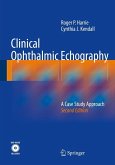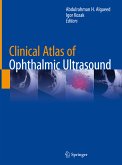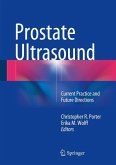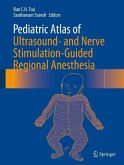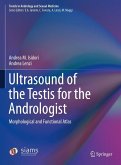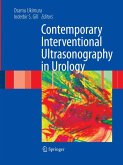

Alle Infos zum eBook verschenken

- Format: PDF
- Merkliste
- Auf die Merkliste
- Bewerten Bewerten
- Teilen
- Produkt teilen
- Produkterinnerung
- Produkterinnerung

Hier können Sie sich einloggen

Bitte loggen Sie sich zunächst in Ihr Kundenkonto ein oder registrieren Sie sich bei bücher.de, um das eBook-Abo tolino select nutzen zu können.
With 308 case studies, coupled with more than 370 ultrasound images, Roger P. Harrie's Clinical Ophthalmic Echography is an indispensable practical guide on how to use ultrasound quickly and reliably to identify eye disorders. This manual serves not only as an excellent procedural review, but also as a great "how-to" for clinicians new to ultrasound.
Chapters cover an array of ocular and orbital problems with which a patient may present, including vitreo-retinal disease, anterior segment problems, vascular lesions, and swollen discs. Dr. Harrie draws upon his broad experience in the…mehr
- Geräte: PC
- ohne Kopierschutz
- eBook Hilfe
- Größe: 7.36MB
![Clinical Ophthalmic Echography (eBook, PDF) Clinical Ophthalmic Echography (eBook, PDF)]() Roger P. HarrieClinical Ophthalmic Echography (eBook, PDF)89,95 €
Roger P. HarrieClinical Ophthalmic Echography (eBook, PDF)89,95 €![Clinical Atlas of Ophthalmic Ultrasound (eBook, PDF) Clinical Atlas of Ophthalmic Ultrasound (eBook, PDF)]() Clinical Atlas of Ophthalmic Ultrasound (eBook, PDF)73,95 €
Clinical Atlas of Ophthalmic Ultrasound (eBook, PDF)73,95 €![Uterine Adenomyosis (eBook, PDF) Uterine Adenomyosis (eBook, PDF)]() Uterine Adenomyosis (eBook, PDF)73,95 €
Uterine Adenomyosis (eBook, PDF)73,95 €![Prostate Ultrasound (eBook, PDF) Prostate Ultrasound (eBook, PDF)]() Prostate Ultrasound (eBook, PDF)73,95 €
Prostate Ultrasound (eBook, PDF)73,95 €![Pediatric Atlas of Ultrasound- and Nerve Stimulation-Guided Regional Anesthesia (eBook, PDF) Pediatric Atlas of Ultrasound- and Nerve Stimulation-Guided Regional Anesthesia (eBook, PDF)]() Pediatric Atlas of Ultrasound- and Nerve Stimulation-Guided Regional Anesthesia (eBook, PDF)169,95 €
Pediatric Atlas of Ultrasound- and Nerve Stimulation-Guided Regional Anesthesia (eBook, PDF)169,95 €![Ultrasound of the Testis for the Andrologist (eBook, PDF) Ultrasound of the Testis for the Andrologist (eBook, PDF)]() Andrea M. IsidoriUltrasound of the Testis for the Andrologist (eBook, PDF)81,95 €
Andrea M. IsidoriUltrasound of the Testis for the Andrologist (eBook, PDF)81,95 €![Contemporary Interventional Ultrasonography in Urology (eBook, PDF) Contemporary Interventional Ultrasonography in Urology (eBook, PDF)]() Contemporary Interventional Ultrasonography in Urology (eBook, PDF)73,95 €
Contemporary Interventional Ultrasonography in Urology (eBook, PDF)73,95 €-
-
-
Chapters cover an array of ocular and orbital problems with which a patient may present, including vitreo-retinal disease, anterior segment problems, vascular lesions, and swollen discs. Dr. Harrie draws upon his broad experience in the ophthalmologic field and imparts his expertise in chapters that range from the evaluation of the painful eye, to basic principles of ultrasound, to echography in developing countries. The varied case studies contained within the chapters include a spectrum of patients across ages and clinical conditions. The studies illuminate the accuracy with which echography both images intraocular and orbital structures and gives valuable information on the status of the lens, vitreous, retina, choroid, sclera, and orbital structures. The book also illustrates how ultrasound is used for diagnostic purposes when pathology is clinically visible, such as differentiating iris and ciliary body lesions, ruling out choroidal and retinal detachments, differentiating intraocular tumors, evaluating serous versus hemorrhagic choroidal detachments, and determining the cause of the proptotic eye. Throughout, the book emphasizes that echography is a cost effective and practical extension of the clinician's diagnostic capability. An extensive display of A-scan images illustrates the valuable addition this modality provides to the more familiar B-scan pictures.
With its case-based approach, concise procedural instruction, and extensive references, this practical manual will prove invaluable in the busy clinical setting.
Dieser Download kann aus rechtlichen Gründen nur mit Rechnungsadresse in A, B, BG, CY, CZ, D, DK, EW, E, FIN, F, GR, HR, H, IRL, I, LT, L, LR, M, NL, PL, P, R, S, SLO, SK ausgeliefert werden.
- Produktdetails
- Verlag: Springer US
- Seitenzahl: 490
- Erscheinungstermin: 27. August 2008
- Englisch
- ISBN-13: 9780387752440
- Artikelnr.: 37287266
- Verlag: Springer US
- Seitenzahl: 490
- Erscheinungstermin: 27. August 2008
- Englisch
- ISBN-13: 9780387752440
- Artikelnr.: 37287266
- Herstellerkennzeichnung Die Herstellerinformationen sind derzeit nicht verfügbar.

